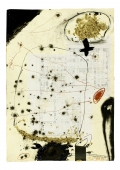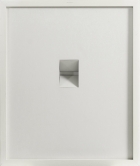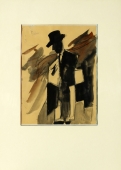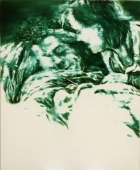
Artist | Andy Warhol (1928 - 1987)
https://www.artist-info.com/artist/Andy-Warhol
 Artist Portfolio Catalog
Artist Portfolio Catalog
| Image | Artist | Title | Year | Material | Measurement | ||||||||||||||||||||
|---|---|---|---|---|---|---|---|---|---|---|---|---|---|---|---|---|---|---|---|---|---|---|---|---|---|
 |
Andy Warhol | One Hundred Campbell's Soup Cans | 1962 | acrylic with stencil on canvas | 183,5 x 132,5 cm | ||||||||||||||||||||

Andy Warhol (1928 - 1987)One Hundred Campbell's Soup Cans
|
|||||||||||||||||||||||||
Biography
Biography
born in 1928, died in 1987
About the work (english / deutsch)
About the work (english / deutsch)
In General
The American artist Andy Warhol, who became the personification of Pop Art, is represented in this Museum by a number of exemplary works from the early Sixties that were previously part of the Ströher Collection.
In comparison with the abstract expressionism that dominated the Forties and Fifties, the painting of Barnett Newman, Mark Rothko or Willem de Kooning, who still followed the partly mythic pictorial themes of the European Tradition, Warhol’s turning toward the realities of modern consumer society appears as an innovative act. Warhol’s particular interest was in the pictorial world of the mass medias, the press, film and television, with their power to shape our experience of reality, and especially in the mythology of the Hollywood star, with which he grew up in a typical American small town. In 1960 the first canvases appeared, handpainted, patterned on the figures and motifs of comic strips and using everyday objects of American consumer society.
Daily News
In the spring and summer of 1962 Warhol used as a model for a number of works the spectacular title page of a tabloid newspaper. The double page spread of the picture Daily News, March 26th 1962, tells us, as „New York’s Picture Newspaper“ for 5 cents, all about sports, politics and a fresh daily helping of the private life of movie stars, in this case Elizabeth Taylor. The choice of pictures reproduces the characteristic appearance of the tabloid.
The pattern was copied onto canvas in pencil with the help of a slide projector and then painted over by Warhol. This ‘hand painted’ picture reproduces the impersonal, printed, newspaperlike character of the original, but as an individual piece of work it contradicts the idea of a newspaper edition running into millions. The link between text and pictures is reminiscent of Warhol’s work as a graphic artist in the advertising industry. By omitting small prints, such as picture captions, Warhol succeeds in evoking a picture gallery with portraits and well known motifs, such as Edgar Degas’ Jockeys, giving us as it were pictures within a picture.
Green Disaster 10 Times / White Burning Car 11
In August 1962 Warhol began working with the photographic silk screen process. The photographic pattern is transferred directly onto the screen by a photochemical process, avoiding the necessity for a drawing. This step takes away even more of the individual finishing process, and it is apparently possible to eliminate the artist’s ‘hand’.
With the car accident pictures, such as Green Disaster 10 Times and White Burning Car 11, both completed in 1963, Warhol begins the series of disaster motifs and finds the way to a basic theme of his early work, pictures of death. He uses various press photographs of serious accidents. The same motif is printed a number of times on a colour grounded canvas. The strong colours, in this case for example a rich turquoise-green, are formally in crass contradiction with the content of the photographs. The repeated reproduction of the motifs on these pictures mirrors on the one hand the fact that hundreds die anonymously on our roads every day, while on the other hand they reproduce yet again the daily paper as a medium, a paper that has already printed 100,000 copies of the tragic picture. The content of these pictures is impersonal, they are pictures of death as a naked reproduction of the everyday. The empty lower part of the picture White Burning Car II points to the countless repetition of auto accidents. The automobile is the true fetish of our civilization. In the case of Green Disaster 10 Times the element of motion is particulary emphasised by the lining up of motifs and the deliberately tilted ‘inexact’ printing. The technique of arranging the motifs in columns is reminiscent of the individual frames of a film strip.
Shot Orange Marilyn
The direct trigger for the portrait series Shot Orange Marilyn was the early death of Marilyn Monroe on August 5th, 1962. It was the most spectacular death of one of the most famous film idols of Hollywood’s star-cult. Warhol chooses as his picture pattern a photographic portrait of Marilyn from a magazine, which reflects the artificiality and superficialitiy of her sex appeal. Marilyn Monroe becomes the Madonna-Icon of the 20th century.
German text by Mario Kramer / Translation by Barbara Norden
(Extract - Full printed version available in the Museum)
MMK - Museum für Moderne Kunst, Frankfurt am Main
Allgemeines
Der amerikanische Künstler Andy Warhol, der zur Personifikation der Pop Art wurde, ist in diesem Museum mit beispielhaften Werken der frühen 60er Jahre aus der ehemaligen Sammlung Ströher vertreten.
Im Vergleich zu der in den 40er und 50er Jahren vorherrschenden Kunst des Abstrakten Expressionismus eines Barnett Newman, Mark Rothko oder Willem de Kooning, die mit ihrer Malerei und den z.T. mythischen Bildthemen noch der europäischen Tradition folgen, erscheint Warhols Hinwendung zu den Realitäten der modernen Konsumgesellschaft als ein innovativer Akt. Warhols besonderes Interesse gilt der die Wirklichkeitserfahrung prägenden Bildwelt der Massenmedien, Presse, Film und Fernsehen, vor allem dem Mythos der Hollywoodstars, mit dem er in einer typisch amerikanischen Kleinstadt aufgewachsen ist. Um 1960 entstehen erste, noch handgemalte Leinwandbilder nach Comic strip-Vorlagen und Motiven mit alltäglichen Gebrauchsgegenständen der amerikanischen Konsumgesellschaft.
Daily News
Im Frühjahr und Sommer 1962 benutzt Warhol für mehrere Werke als Bildvorlage eine spektakuläre Titelseite einer Boulevardzeitung. Die Doppelseite des Bildes Daily News vom 29. März 1962 berichtet als „New York’s Picture Newspaper“ für 5 Cents über Sport, Politik und tagesfrische persönliche Schicksale aus dem Privatleben der Leinwandstars, in diesem Fall Elizabeth Taylor. Die Bildauswahl gibt das charakteristische Erscheinungsbild einer Boulevardzeitung wieder.
Die Vorlage wurde mit Hilfe der Diaprojektion mit Bleistift auf die Leinwand kopiert und von Warhol nachgemalt. Das handgemalte Bild bewahrt zwar das Unpersönliche, Gedruckte und Zeitungshafte der Bildvorlage, widerspricht jedoch als Einzelstück der millionenfachen Auflagenhöhe er Tageszeitung. Die Verbindung von Schrift und Bild erinnert noch an Warhols Tätigkeit als Werbegraphiker. Durch das Weglassen des Kleingedruckten, etwa der Bildunterschriften, gelingt es Warhol, den Eindruck einer Bildergalerie mit Porträts und bekannten Bildmotiven, wie Edgar Degas’ Jockeys, zu erwecken, sozusagen als Bilder im Bild.
Green Disaster 10 Times / White Burning Car II
Im August 1962 beginnt Warhol mit Fotosiebdruck zu arbeiten. Die unmittelbare fotochemische Übertragung der Fotovorlage auf das Sieb erspart eine Vorzeichnung. Durch diesen Schritt wurde noch mehr von der individuellen Fertigung zurückgenommen, und es gelingt die scheinbare Eliminierung der künstlerischen Handschrift.
Mit den Bildern von Autounfällen, wie Green Disaster 10 Times und White Burning Car II, beide von 1963, nimmt Warhol die Serie der Disaster-Motive auf und findet damit zu seinem eigentlichen Thema des Frühwerks, den Todesbildern. Er verwendet verschiedene Pressefotos von schweren Autounfällen. Das jeweils gleiche Motiv wird mehrfach auf die farbig grundierte Leinwand gedruckt. Die kräftigen Farben, hier zum Beispiel das satte Türkisgrün, stehen formal in krassem Gegensatz zum Inhalt der Fotovorlagen. Die vielfache Reproduktion der Motive auf den Bildern spiegeln einerseits den 100fachen tagtäglichen anonymen Tod auf den Straßen wider, andererseits sind sie eine weitere Reproduktion des Mediums Tageszeitung, das das Unglücksbild bereits 100.000fach abgedruckt hat. Es sind Bilder unpersönlichen Inhalts, Bilder vom Tod als bloßer Reproduktion des Alltäglichen. Das untere Bildfeld bei White Burning Car II veranschaulicht die unzählbare Wiederholbarkeit von Autounfällen. Das Auto ist der eigentliche Fetisch unserer Zivilisation.
Bei Green Disaster 10 Times wird das Bewegungselement durch die Reihung des Motivs und den bewußt schrägen ungenauen’ Druck besonders deutlich. Die Reihung des Motivs in Spalten erinnert formal an die Phasenbilder eines Filmstreifens.
Shot Orange Marilyn
Unmittelbarer Auslöser für die Porträt-Serie von Shot Orange Marilyn war der frühe Tod Marilyn Monroes am 5. August 1962. Es war der spektakulärste Todesfall eines der berühmtesten Filmidole des Starkults von Hollywood. Warhol wählte als Bildvorlage ein Fotoporträt von Marilyn aus einer Illustrierten, das die Künstlichkeit und die Oberfläche ihres Sex-Appeals widerspiegelt. Marilyn Monroe wird zur Madonnen-Ikone des 20. Jahrhunderts.
Text von Mario Kramer
(Auszug - Der vollständige Text ist als Informationsblatt beim Museum erhältlich)
MMK - Museum für Moderne Kunst, Frankfurt am Main
 Exhibition Announcements
Exhibition Announcements
| Image | Opening | Closing | City/Country | Exhibition Place | Exhibition Title |
|---|
 offers / Requests offers / Requests  |
Learn more about this service |
|---|
 Visualization |
Learn more about this service | ||
|---|---|---|---|

Interested in discovering more of this artist's networks?
3 easy steps: Register, buy a package for a visualization, select the artist.
See examples how visualization looks like for an artist, a curator, or an exhibition place: Gallery, museum, non-profit place, or collector.

Exhibition History

|
SUMMARY based on artist-info records. More details and Visualizing Art Networks on demand. Venue types: Gallery / Museum / Non-Profit / Collector |
||||||||||||
| Exhibitions in artist-info | 942 (S 284/ G 658) |
Did show together with - Top 5 of 7427 artists (no. of shows) - all shows - Top 100
|
||||||||||
| Exhibitions by type | 942: 399 / 342 / 183 / 18 | |||||||||||
| Venues by type | 503: 210 / 174 / 110 / 9 | |||||||||||
| Curators | 326 | |||||||||||
| artist-info records | Jun 1952 - Jul 2023 | |||||||||||
|
Countries - Top 5 of 28 United States (392) Germany (230) United Kingdom (43) Switzerland (38) France (30) |
Cities - Top 5 of 194 New York (232) London (41) Los Angeles (35) Berlin (33) Frankfurt am Main (32) |
Venues (no. of shows ) Top 5 of 503 | ||||||||||
Curators (no. of shows)
Top 5 of 326
|
| Von der Heydt-Museum | G | Aug 2022 - Jan 2023 | Wuppertal | (131) | +0 | |
| Storm, Anna (Curator) | +0 | |||||
| Von der Heydt-Museum | G | Apr 2022 - Jul 2023 | Wuppertal | (131) | +0 | |
| Bruns, Anika (Curator) | +0 | |||||
| Eickhoff, Beate (Curator) | +0 | |||||
| Whitechapel Gallery | G | Feb 2022 - Jun 2022 | London | (416) | +0 | |
| Blazwick, Iwona (Curator) | +0 | |||||
| Dallas Museum of Art | S | Jul 2021 - Nov 2021 | Dallas | (94) | +0 | |
| Museum moderner Kunst Stiftung Ludwig - mumok | G | Jun 2021 - Apr 2022 | Wien | (48) | +0 | |
| Ammer, Manuela (Curator) | +0 | |||||
| Art Gallery of Ontario - AGO | S | Mar 2021 - Jun 2021 | Toronto - Ontario | (23) | +0 | |








































